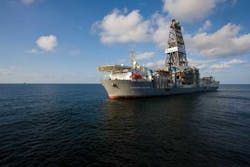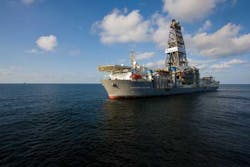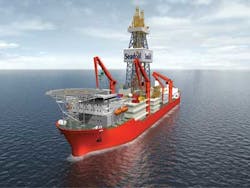Robin Dupre
Senior Technology Editor
As a slew of newbuild drilling rigs hit the market in 2015, coupled with oil companies slashing budgets due to surging costs, it is speculated that the industry will witness an acceleration in the rate of marginalization of legacy assets.
"We saw spending from operators dry up in 2014," said Terry Bonno, senior vice president, marketing, Transocean, in a recent interview withOffshore magazine. "And then the budget results just came out, so I am not sure if we fully understand, yet, the impact on the global universe, but initial signs are that they are reducing their budgets for 2015."
"If you are looking at the overall rig fleet right now, you are seeing a bit of idling of rigs in all of the asset classes," Bonno added. "In our last fleet status report that was filed, we stated that we intend to scrap some of our lower specification units. Our theme for 2015, once we saw this difficult market coming, is to fight for utilization."
As most drilling companies that have rigs without a contract, today, are idling or cold-stacking these rigs, it is estimated that around 140 rigs are heading toward retirement over the next few years as the industry makes way for the newbuilds scheduled for delivery by the end of the decade. Around 360 rigs that are in the current market fleet are more than 30 years old and must be retired at some point.
Moreover, analysts estimate that around one-third of the new vessels that are in the pipeline for the next three to four years still have no drilling contracts. Rune Magnus Lundetrae, CFO of Seadrill, was quoted by Reuters in September 2014 to say that the market could need another 24 months to bottom out, though for older assets, rates were already near the bottom and he expected older vessels to be idled.
Cinnamon Odell, senior analyst–rigs, IHS Petrodata, toldOffshore that "we expect to see fewer orders for new rigs, as well as some cancellations and/or deferment of rigs that have already been ordered from yards."
For instance, Atwood Oceanics filed its fleet status report last month, announcing that it would postpone the delivery of two newbuild vessels. TheAtwood Admiral will not be delivered until September 2015, while the Atwood Archer is delayed until June 2016. "More contract drillers are exploring this option to ease the pressure to sign contracts at less than ideal day rates," Odell said.
Seadrill's Lundetrae sounded an even more pessimistic note, with hope for the not-too-distant future. "The market is going to be bad this year, it is going to be worse next year, then it will stabilize," Lundetrae told Reuters last September.
Day rates for the most advanced ultra-deepwater rigs peaked around $650,000 last year and are now down in a range of $375-$500,000, though contracting activity by oil firms has slowed to a trickle, making it hard to establish the actual market rate, executives told Reuters.
Rates for jackups have also fallen, though not as much as deepwater floaters, with executives predicting rates at around $160,000 per day, down from rates around $225,000 at its peak.
The jackup market helped drillers last year, with Saudi Aramco, PEMEX, Oil and Natural Gas Corp., and China National Offshore Oil Corp. consuming around 30% of the business with return contracts. But this year, there are 138 jackups on order or under construction. The current rig order book, with deliveries scheduled for 2015, are at a plus or minus of 60: 20 to be delivered in the first half of the year, and 40 for delivery in the second half. This information was offered by John T. Rynd, CEO and president, Hercules Offshore, at a recent Wells Fargo Energy Symposium presentation.
"All of these orders are being financed by a shipyard, but the builder has full recourse back to the shipyard and can refuse to take delivery," Rynd observed. "I assume all will be built with delivery being pushed back to 2019. Thus far, we've seen four jackup contracts get canceled, so let's see what happens in the near future."
This is a temporary phenomenon, says John Breed, director, investor relations and corporate communications, Noble Corp. Breed offered remarks at the Capital One Securities 2014 Energy Conference. "This business will balance itself out, with part of that being because of attrition," Breed commented. "It is a word that we do not spend a lot of time talking about in this business, but I think it will become a real issue as we go forward because of the average age of the fleets."
Transocean's Bonno agrees with that sentiment. "If older rigs can't economically remain as part of the core fleet or in the global fleet, I think a decision has to be taken on attrition," she said. "As we move forward in the over-supplied market, certainly attrition is going to be a factor in bringing this market back into balance. This is what the cycle is going to be marked for: reassessing the current rig fleet."
As for geographical areas, it is predicted that offshore Mexico and Brazil could pick-up some of the slack while drilling in the North Sea, Africa, and the Gulf of Mexico could slow down even further.
The names on the accompanying list of the Top 10 drilling contractors by number of rigs are similar to those presented last year, with a few noted changes. Noble, No. 2 last year, dropped to ninth place as it now possesses fewer rigs, due to its recent spin off of Paragon Offshore, a standard offshore drilling company. Paragon has entered the list at No. 6, as well as COSL Drilling Europe AS and Shelf Drilling, a private company headquartered in Dubai.
The number of rigs under construction has continued to grow, but is lower than last year's numbers, for a total of 36. This growth has been driven by a number of new high-specification jackup orders.
Now that commodity prices have declined, the industry will see a direct effect on the jackup market, which is a different experience from last year's overview. "We don't think that the jackup demand is going to help keep rates like it did in 2014, especially if the commodity prices stay low," Odell observed. "Further impacting the problem for this market is the influx of rigs that are scheduled for delivery. There are over 70 jackups that are scheduled for delivery in 2015 alone."
If all of those jackup rigs actually come out on the market on time, with commodity prices so low, that would be a huge problem, Odell comments. "Rates would plummet. These newbuilds would either be canceled or be delayed. There's not a demand in the market for another 70 rigs."
As for what to expect with the newbuild contracts and/or orders, Odell states that as delivery dates approach, drillers are going to be cautious, resulting in a case-by-case basis. As the year progresses, the industry will have a more defined picture of what to expect going into 2016.
While the ultra-deepwater arena typically has weathered the storm in past down cycles, it is predicted that this will ring true again, near-term. "We're not expecting for the UDWs to be cold-stacked this year or next," she added. "Those rigs will likely have either small gaps or work down specifications. By that, I mean the rigs that are capable of working in water depths greater than 7,500 ft [2,286 m]."
As for floaters, many already have contracts in hand, but the industry will expect to see re-negotiation of the daily rate or terms adjusted to make it more palatable for the operator and contractor. For those coming out of the shipyard without contracts, expect to see some time gaps, but they will not stack them right away, Odell says.
Transocean, which came in at number one on the list, recently provided an update on its activities. In conference calls with analysts last quarter, Transocean officials stated that the company's newbuild program remains on track, with near-term drillship deliveries backed by long-term contracts at "attractive" day rates.
Transocean received encouraging interest from customers for five of its speculative jackups that are under construction. "We will continue to pursue corporate contracts for the 2016 and 2017 deliveries," said Steven Newman, Transocean's president and CEO.
As for the company's non-core fleet, Transocean intends to scrap certain cold-stacked rigs, recognizing their limited potential to re-enter the market, while continuing to assess the competitiveness of non-core assets on a case-by-case basis with the likelihood of retiring additional rigs.
The company announced it signed a one-well extension on theDiscoverer Enterprise drillship with a rate of about $398,000 per day. The agreement also includes four, one-well pricing options.
Bonno added in the analyst call that UDW day rates and utilization have remained under pressure while customers continue to focus on short-term cash flows and capital allocation. "We are pleased to see the supply of available rigs decline as a result of the recent and expected announcement of contract awards in Brazil, US Gulf of Mexico and West Africa," she said. "However, we continue to expect challenging conditions as we work to contract our rigs in an oversupplied market, and are likely to experience inter-contract idle times and significant competition on the limited tendering opportunities available."
Bonno added that deepwater and mid-water markets remain weak as higher-specification units compete for lower specification jobs, with the expectation that this will drive older, less capable units out of the market and additional units will be retired.
The company also expects Petrobras to announce the Libra field development tender winners, which could involve up to three Transocean rigs in 2015.
As for other geographical areas, in 3Q 2014, the company secured a contract for its deepwater semisubmersible Jack Bates in Australia, with hopes of securing three long-term tenders in India in the very near future for rigs capable of drilling in 5,000 ft (1,524 m) of water.
Midwater and harsh environments tendering activity also remained slow in 3Q 2014, and Transocean expects it to remain that way in 2015. "The recent contract terminations and suspensions by Statoil in Norway, the Russian sanctions, delayed programs, and limited programs overall continue to challenge the UK and Norwegian market," Bonno commented.
TheTransocean Spitsbergen recently received a contract suspension notice from Statoil, reducing the day rate by about 25%. The company recently secured a four-year contract for the Transocean Leader in the UK. The rig will move south upon completion of her contract in Norway. The rate is favorable, say Transocean officials, as the first three years will be paid at a rate of $335,000, and the last year will be at a rig market rate between $335,000 to $365,000 per day.
In October 2014, Transocean signed a contract to returnTransocean Amirante to work on a one-year charter in Libya at a rate of $335,000 per day.
Transocean also extended the contract forTransocean Honor for one year at a rate of $194,000 per day for work in Angola, but it expects new fixed rates to decline for high-spec jackups over the next 12 months.
In November 2014, Seadrill Ltd. entered into an agreement with Seadrill Partners to sell all of the ownership interest in the entities that own and operate the drillshipWest Vela to Seadrill Capricorn Holdings LLC, Seadrill Partners' 51%-owned subsidiary.
TheWest Vela is a sixth-generation, dynamically positioned drillship delivered from the Samsung shipyard to its current customer, BP, in November 2013. The West Vela is expected to carry out operations in the US GoM until the end of its contract in November 2020.
The implied purchase price of the acquisition is $900 million, less $433 million of debt outstanding under the existing facility financing the West Vela. Based on Seadrill Partners' 51% ownership of Capricorn Holdings, its portion of the net purchase price after debt will be $238 million.
Noble Corp. predicts that 2015 will pose a challenge for the drilling industry, but officials deem the company to be well positioned to move forward during this down cycle.
"We believe younger fleets are preferred in this business as we go forward," said Noble's John Breed, "because they will have limited exposure to the market meaning utilization will remain high and they will get the best rates that the market is paying at the time. Ultimately, the company will receive a premium evaluation as the result of our new fleet."
As for its fleet going into 2015, there are several secured contracts, but a few rigs will sit idle:
- Noble Paul Wolff has sat idle in a shipyard in Singapore since late October 2014, and the company plans to leave it idle in 2015. Noble states that it is undergoing regulatory survey and repair and maintenance projects.
- Noble Homer Ferrington has been cold-stacked and will not be active in 2015.
- Noble Max Smith has sat idle in a shipyard in Singapore since late October 2014 and it is currently available.
- Noble Paul Romano is currently in the Canary Islands and is available.
- Noble Sam Hartley will remain idle in 2015.
- Noble Tom Prosser's contract is expected to begin in 1Q 2015, following transit from Singapore to Australia, and upon successful acceptance testing by Apache. The rig will stay with Apache until 2Q 2016 at a day rate of $203,500.
- Noble Lloyd Noble is under construction at the Jurong Shipyard. Statoil contracted the rig for four years and it is anticipated to commence during 3Q 2016. The ultra-high specification jackup is an enhanced version of Statoil's "Cat J" specifications, and will be designed to operate in water depths of up to 150 m (492 ft) in harsh environmental conditions, with a maximum total drilling depth capacity of 10,000 m (approximately 33,000 ft).
In its 3Q earnings call, Hercules Offshore stated that it had cold-stacked four jackups:Hercules 202, Hercules 204, Hercules 212, and Hercules 213.
It is expected that theHercules 208 will come off the contract from Cairn in March, and will then be sent to Singapore. "The outlook on that rig is [that] it will sit idle until at least October 2015 with opportunities, hopefully, presenting itself later in the year," said Rynd, "but [we expect] nothing in the interim."
As forHercules 261 and 262, both have secured contracts until 2019; and the outlook for Hercules 266 and 267 is very good. "We are looking to contract them through 2015," Rynd added.
Rowan Companies, last on the Top 10 list, has several projects in the works.
- Rowan Relentless, contracted for construction by Hyundai Heavy Industries (HHI), is expected for delivery at the end of March 2015. The rig is contracted for a two-year drilling term commencing 3Q 2015.
- TheRowan Reliance rig departed HHI shipyard early November 2014. The rig is contracted for a three-year drilling term commencing late February 2015. The expected off-rate time for annual dynamic positioning trials will occur sometime during 2015, the company stated in its 3Q earnings call.
- Middle East:Hank Boswell, Bob Keller, Scooter Yeargain, Rowan Mississippi, and Bob Palmer all secured contracts with Saudi Aramco.
- Southeast Asia:Gorilla II has secured a contract through late 2015. This may be mobilized out of Southeast Asia after the contract ends, the company said.
- Rowan Juneau and Rowan Alaska have been cold-stacked and are available.
About the Author

Robin Dupre
Sr. Technology Editor
Robin Dupre is Sr. Technology Editor of Offshore magazine as well as Domestic Editorial Conference Director of three PennWell conferences. Robin has 10 years of experience publishing content for print and online platforms, and she has spent the last 6 years covering the oil and gas industry.



